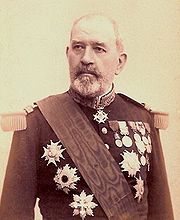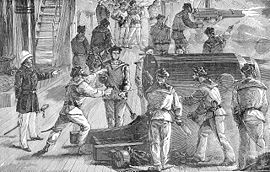
Far East Squadron
Encyclopedia



Sino-French War
The Sino–French War was a limited conflict fought between August 1884 and April 1885 to decide whether France should replace China in control of Tonkin . As the French achieved their war aims, they are usually considered to have won the war...
(August 1884–April 1885).
Background
In 1882 French interests in the Far East were protected by two naval divisions, the Cochinchina naval division (based at Saigon) and the Far East naval division (based at Yokohama). The Cochinchina naval division (division navale de Cochinchine) was responsible for monitoring coastal navigation between Singapore and the Hainan Strait and along the rivers of Cochinchina and Cambodia, while the Far East naval division (division navale de l'Extrême-Orient) policed the China Coast and the seas around China and Japan. Henri Rivière's intervention in Tonkin in April 1882 was made with vessels of the Cochinchina naval division. As France increased its commitment in Tonkin after Rivière's defeat and death at the Battle of Paper BridgeBattle of Paper Bridge
The Battle of Cầu Giấy or Paper Bridge, fought on 19 May 1883, was one of the numerous clashes during the Tonkin campaign between the French and the Black Flags...
, a naval division was created at the end of May 1883 to patrol the Gulf of Tonkin. Command of this new Tonkin Coasts naval division (division navale des côtes du Tonkin) was given to Admiral Amédée Courbet
Amédée Courbet
Anatole-Amédée-Prosper Courbet was a French admiral who won a series of important land and naval victories during the Tonkin campaign and the Sino-French War .-Early years:...
. A Tonkin Flotilla
Tonkin Flotilla
The Tonkin Flotilla , a force of despatch vessels and gunboats used for policing the rivers and waterways of the Tonkin Delta, was created in the summer of 1883, during the period of undeclared hostilities that preceded the Sino-French War .-Background:In March 1882, on the eve of Commandant Henri...
(flotille de Tonkin), consisting of a number of despatch vessels and gunboats, was also created for inland operations in the summer of 1883, and placed under the command of général de brigade Alexandre-Eugène Bouët (1833–87), the French commandant supérieur in Tonkin.
Composition
The Far East squadron was formally constituted on 27 June 1884, in response to the news of the Bac Le ambushBac Le ambush
The Bac Le ambush was a clash during the Tonkin campaign in June 1884 between Chinese troops of the Guangxi Army and a French column sent to occupy Lang Son and other towns near the Chinese border. The French claimed that their troops had been ambushed by the Chinese...
, by the amalgamation of the Tonkin Coasts naval division and the Far East naval division. The Tonkin Coasts naval division, under the command of Admiral Amédée Courbet
Amédée Courbet
Anatole-Amédée-Prosper Courbet was a French admiral who won a series of important land and naval victories during the Tonkin campaign and the Sino-French War .-Early years:...
since July 1883, consisted of the ironclads Bayard
French battleship Bayard (1880)
The Bayard was an early stationary battleship of the French Navy, lead ship of her class. Bayard had a wooden hull and a full rigging, as well as a side armour and steam machinery.- Active service :...
(the flagship) and Atalante, the cruiser Châteaurenault, the light frigates Hamelin and Parseval, the gunboats Lynx, Vipère and Aspic, the troopships Drac and Saône and Torpedo Boats Nos. 45 and 46. The Far East naval division, under the command of Admiral Sébastien Lespès
Sébastien Lespès
Sébastien-Nicolas-Joachim Lespès was a French admiral who played an important role in naval operations during the Sino-French War , as second-in-command of Admiral Amédée Courbet's Far East Squadron.- Early career :...
since March 1884, consisted of the ironclads La Galissonnière (the flagship) and Triomphante, the cruisers d'Estaing, Duguay-Trouin and Volta, and the gunboat Lutin. The new squadron was placed under Courbet's command, with Lespès second in command.
In October 1884 the squadron was joined by the cruisers Rigault de Genouilly from the Levant station, Nielly from the Indian Ocean station and Champlain. At the end of November 1884 a fourth cruiser, Éclaireur, arrived from the Pacific station. In January 1885 the squadron was joined by the cruisers Duchaffaut from New Caledonia and Lapérouse
French cruiser Lapérouse
The Lapérouse was a barbette cruiser of the French Navy, lead ship of her class, named after Jean-François de Galaup, comte de Lapérouse....
from France. Around the end of March 1885 the cruiser Kerguelen, transferred from the Pacific station, joined the squadron. French naval forces in Tonkin were strongly reinforced in the spring of 1885 by the cruisers Fabert and La Clocheterie, and the seagoing gunboat Jaguar, previously based at Along Bay as part of the Tonkin flotilla, was also transferred to the Far East squadron at this period.
In April 1885 the squadron was reinforced by a third naval division, sent out from France in January 1885 under the command of Admiral Adrien-Barthélémy-Louis Rieunier. Rieunier's division consisted of the ironclad Turenne (his flagship), the cruisers Magon, Primauguet and Roland, and the gunboats Comète and Sagittaire. The division was accompanied by two more torpedo boats, Nos. 44 and 45, and by the 'auxiliary cruiser' Château-Yquem, a civilian vessel leased and armed by the French government for the duration of hostilities with China. Rieunier's division reached Far Eastern waters too late to take part in active naval operations, but some of its ships took part in the continuing French blockade of the Yangzi River between April and June 1885.
In April 1885, at the end of the Sino-French War, the squadron consisted of the following vessels:
- Ironclads: BayardFrench battleship Bayard (1880)The Bayard was an early stationary battleship of the French Navy, lead ship of her class. Bayard had a wooden hull and a full rigging, as well as a side armour and steam machinery.- Active service :...
, La Galissonnière, Turenne, Triomphante, Atalante
- Cruisers (1st Class): Duguay-Trouin, Villars, d'Estaing, LapérouseFrench cruiser LapérouseThe Lapérouse was a barbette cruiser of the French Navy, lead ship of her class, named after Jean-François de Galaup, comte de Lapérouse....
, Nielly, Magon, Primauguet, Roland
- Cruisers (2nd Class): Champlain, Châteaurenault, Éclaireur, Rigault de Genouilly
- Cruisers (3rd Class): Kerguelen, Volta, Duchaffaut
- Avisos-transports: Saône
- Gunboats: Lutin, Vipère, Lynx, Comète, Sagittaire, Aspic, Jaguar
- Transports (1st Class): Annamite, Tonkin
- Auxiliary Cruisers: Château-Yquem
- Torpedo Boats (2nd Class): Nos. 44, 45, 46 and 50.
Admiral Courbet died aboard his flagship Bayard in Magong harbour in the Pescadores on 11 June 1885, and was briefly succeeded in command of the squadron by Admiral Sébastien Lespès
Sébastien Lespès
Sébastien-Nicolas-Joachim Lespès was a French admiral who played an important role in naval operations during the Sino-French War , as second-in-command of Admiral Amédée Courbet's Far East Squadron.- Early career :...
. On 25 July 1885 the French government reconstituted the traditional Far East naval division at close to its 1883 strength. The division, under the command of Admiral Lespès, with Rieunier second in command, consisted of the ironclads La Galissonnière (the flagship), Turenne and Triomphante, the cruisers Lapérouse
French cruiser Lapérouse
The Lapérouse was a barbette cruiser of the French Navy, lead ship of her class, named after Jean-François de Galaup, comte de Lapérouse....
, Primauguet, Champlain and Roland, and the gunboats Vipère and Sagittaire. The other ships returned to France, or were transferred to Tonkin, or were sent to the various stations of the French fleet around the globe:
Around the end of June each day saw the departure of one of our ships. D’Estaing and Kerguelen were the first to leave, towing Torpedo Boats Nos. 50 and 44 as far as Saigon, then continuing on to France. Villars and Éclaireur followed them, while Château-Yquem conveyed troops, artillery and mules to Along Bay. Then Annamite left, to repatriate the sick. Duguay-Trouin and Châteaurenault went next, to return to France. Magon and Fabert went back to the Pacific station, and Rigault de Genouilly to the Levant station. A little later Atalante left to decommission in Saigon, Nielly joined the Indian Ocean station and La Clocheterie, Lutin and Comète left for Tonkin to join General de Courcy’s command.
Operations

Keelung
Keelung City is a major port city situated in the northeastern part of Taiwan. It borders New Taipei and forms the Taipei–Keelung metropolitan area, along with the Taipei and New Taipei. Nicknamed the Rainy Port for its frequent rain and maritime role, the city is Taiwan's second largest seaport...
on 5 August 1884, directed by Rear Admiral Lespès. The landing force put ashore by Lespès on the afternoon of 5 August to occupy Keelung consisted of the landing companies of Bayard and Villars, under the respective commands of capitaine de frégate Martin and lieutenant de vaisseau Jacquemier. Both companies were attacked by superior Chinese forces on the morning of 6 August, and had to make a fighting withdrawal to the coast, where they were re-embarked. French casualties in this operation were 2 dead and 11 wounded.
Other ships were involved in the Battle of Fuzhou (23 August 1884), various operations in the Keelung Campaign
Keelung Campaign
The Keelung Campaign was a controversial military campaign undertaken by the French in northern Formosa during the Sino-French War. After making a botched attack on Keelung in August 1884, the French landed an expeditionary corps of 2,000 men and captured the port in October 1884...
, including landings at Keelung
Keelung
Keelung City is a major port city situated in the northeastern part of Taiwan. It borders New Taipei and forms the Taipei–Keelung metropolitan area, along with the Taipei and New Taipei. Nicknamed the Rainy Port for its frequent rain and maritime role, the city is Taiwan's second largest seaport...
and Tamsui (1 to 8 October 1884), the blockade of Formosa (October 1884 to April 1885), the Battle of Shipu
Battle of Shipu
The Battle of Shipu was a French naval victory during the Sino-French War . The battle took place on the night of 14 February 1885 in Shipu Bay , near Ningbo, China.- Background :...
(14 February 1885), the so-called Battle of Zhenhai
Battle of Zhenhai
The so-called Battle of Zhenhai was a minor confrontation on 1 March 1885 between Admiral Amédée Courbet's Far East Squadron and Chinese warships and shore batteries near the coastal city of Zhenhai, 12 miles downstream of Ningbo, during the Sino-French War...
(1 March 1885), the Pescadores Campaign
Pescadores Campaign
The Pescadores Campaign in late March 1885 was one of the last campaigns of the Sino-French War . It was fought to capture a strategically important island group off the western coast of Taiwan...
(March 1885) and the 'rice blockade' of the Yangtze River
Yangtze River
The Yangtze, Yangzi or Cháng Jiāng is the longest river in Asia, and the third-longest in the world. It flows for from the glaciers on the Tibetan Plateau in Qinghai eastward across southwest, central and eastern China before emptying into the East China Sea at Shanghai. It is also one of the...
(March to June 1885). There were also a number of exploits by individual vessels. The light frigate Parseval, sent to Shanghai in the summer of 1884 to observe the movements of China's Southern Seas fleet, made a daring night escape under the guns of the Wusong forts in September 1884.
Losses

Torpedo Boat No. 45, which had fought in the Battle of Fuzhou, was lost at sea on 21 March 1885 while sailing to Ningbo to join the French vessels blockading the mouth of the Yangzi River. Torpedo Boat No. 46, which had attacked and sunk the Chinese corvette Yangwu during the Battle of Fuzhou, was lost at sea off Makung on 30 April 1885, shortly after the end of the Sino-French War. Both torpedo boats were lost while under tow (by Châteaurenault and d'Estaing respectively), and on both occasions foundered after the towing rope snapped. There were no casualties in either incident.
The battle losses of the ships' crews and the squadron's landing companies were moderate. The squadron suffered minor losses in the Battle of Fuzhou and the subsequent descent of the Min River, and rather heavier casualties on 8 October 1884 in the failed landing at Tamsui during the Keelung Campaign
Keelung Campaign
The Keelung Campaign was a controversial military campaign undertaken by the French in northern Formosa during the Sino-French War. After making a botched attack on Keelung in August 1884, the French landed an expeditionary corps of 2,000 men and captured the port in October 1884...
. French casualties in the Battle of Shipu
Battle of Shipu
The Battle of Shipu was a French naval victory during the Sino-French War . The battle took place on the night of 14 February 1885 in Shipu Bay , near Ningbo, China.- Background :...
were minimal. Several sailors died of cholera during the four-month occupation of the Pescadores Islands following the Pescadores Campaign
Pescadores Campaign
The Pescadores Campaign in late March 1885 was one of the last campaigns of the Sino-French War . It was fought to capture a strategically important island group off the western coast of Taiwan...
.

